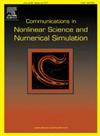一种基于二维D2Q9累积量的晶格玻尔兹曼方法:跨多种流动现象的模拟与验证
IF 3.8
2区 数学
Q1 MATHEMATICS, APPLIED
Communications in Nonlinear Science and Numerical Simulation
Pub Date : 2025-09-19
DOI:10.1016/j.cnsns.2025.109327
引用次数: 0
摘要
本研究提出了一种新的二维(2D)累积晶格玻尔兹曼方法(CuLBM),称为D2Q9 CuLBM,该方法已使用计算单元设备架构(CUDA) C/ c++实现,以利用图形处理单元(GPU)计算来提高效率和性能。基于累积量的晶格玻尔兹曼方法是计算流体动力学(CFD)方法的最新进展,旨在提供更好的稳定性和准确性,特别是在模拟复杂流体流动方面。本文全面介绍了D2Q9 CuLBM配方,重点介绍了其在几种基准和复杂流体流动情况下的应用。众所周知的验证试验包括盖子驱动腔体(LDC)流动和后向台阶(BFS)流动,两者都经常用于CFD中评估数值方法的准确性和稳定性。此外,该模型还对周期性双剪切层流动(流动稳定性的挑战问题)、Green-Taylor涡和Kida-Pelz涡进行了评估,并扩展到剪切依赖的非牛顿流体,特别是那些服从幂律和Bingham模型的盖驱动腔、Couette和Poiseuille流动。这些非牛顿情况对于捕获具有复杂流变特性的流体至关重要,证明了D2Q9 CuLBM方法在处理广泛的流体动力学问题方面的通用性和准确性。本文章由计算机程序翻译,如有差异,请以英文原文为准。
A novel two-dimensional D2Q9 cumulant-based lattice Boltzmann method: simulation and validation across multiple flow phenomena
This study presents a novel two-dimensional (2D) cumulant lattice Boltzmann method (CuLBM), known as D2Q9 CuLBM, which has been implemented using compute unit device architecture (CUDA) C/C++ to leverage graphics processing unit (GPU) computing for enhanced efficiency and performance. The cumulant-based lattice Boltzmann approach is a recent advancement in computational fluid dynamics (CFD) methods designed to offer improved stability and accuracy, particularly for simulating complex fluid flows. This work comprehensively describes the D2Q9 CuLBM formulation, focusing on its application to several benchmark and complex fluid flow cases. The well known validation tests include lid-driven cavity (LDC) flow and backward-facing step (BFS) flow, both frequently used in CFD to assess the accuracy and stability of numerical methods. Additionally, the model is evaluated on periodic double shear layer flow, a challenging problem for flow stability, Green–Taylor vortex and Kida–Pelz vortex flows and extended to shear-dependent non-Newtonian fluids, specifically those obeying power-law and Bingham models in the lid driven cavity, Couette and Poiseuille flows. These non-Newtonian cases are critical for capturing flows with complex rheological properties, demonstrating the versatility and accuracy of the D2Q9 CuLBM approach in handling a broad spectrum of fluid dynamics problems.
求助全文
通过发布文献求助,成功后即可免费获取论文全文。
去求助
来源期刊

Communications in Nonlinear Science and Numerical Simulation
MATHEMATICS, APPLIED-MATHEMATICS, INTERDISCIPLINARY APPLICATIONS
CiteScore
6.80
自引率
7.70%
发文量
378
审稿时长
78 days
期刊介绍:
The journal publishes original research findings on experimental observation, mathematical modeling, theoretical analysis and numerical simulation, for more accurate description, better prediction or novel application, of nonlinear phenomena in science and engineering. It offers a venue for researchers to make rapid exchange of ideas and techniques in nonlinear science and complexity.
The submission of manuscripts with cross-disciplinary approaches in nonlinear science and complexity is particularly encouraged.
Topics of interest:
Nonlinear differential or delay equations, Lie group analysis and asymptotic methods, Discontinuous systems, Fractals, Fractional calculus and dynamics, Nonlinear effects in quantum mechanics, Nonlinear stochastic processes, Experimental nonlinear science, Time-series and signal analysis, Computational methods and simulations in nonlinear science and engineering, Control of dynamical systems, Synchronization, Lyapunov analysis, High-dimensional chaos and turbulence, Chaos in Hamiltonian systems, Integrable systems and solitons, Collective behavior in many-body systems, Biological physics and networks, Nonlinear mechanical systems, Complex systems and complexity.
No length limitation for contributions is set, but only concisely written manuscripts are published. Brief papers are published on the basis of Rapid Communications. Discussions of previously published papers are welcome.
 求助内容:
求助内容: 应助结果提醒方式:
应助结果提醒方式:


